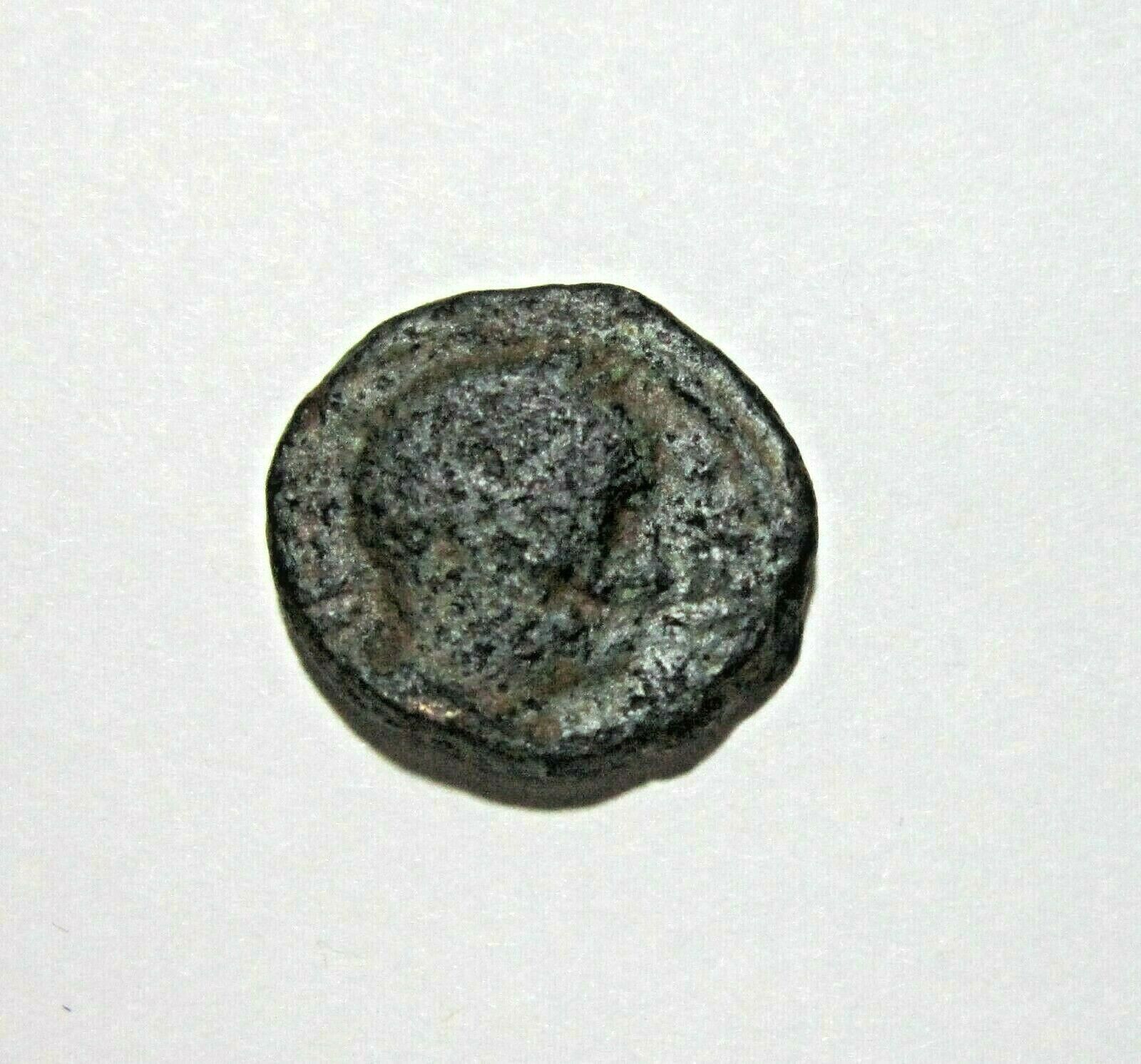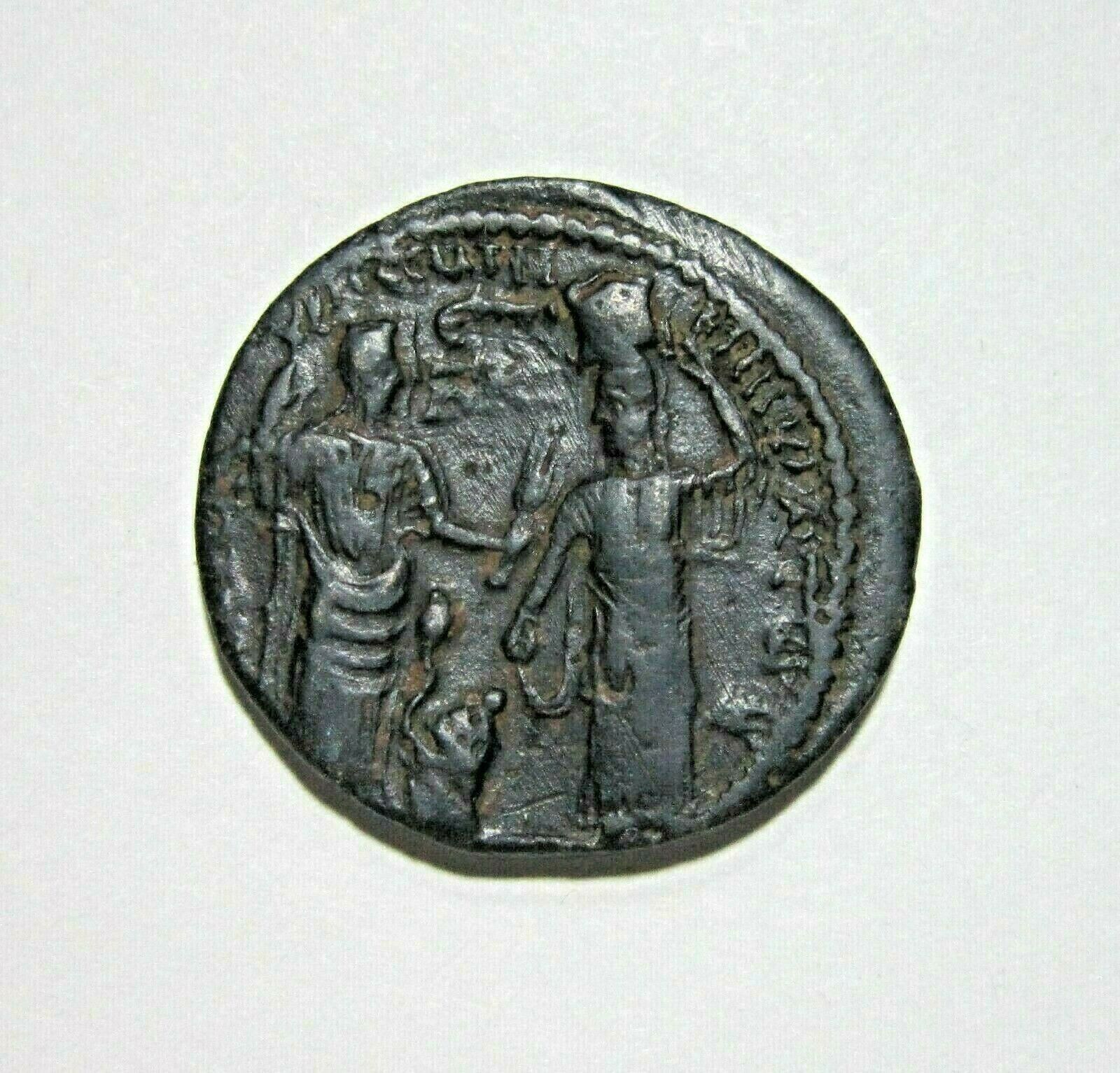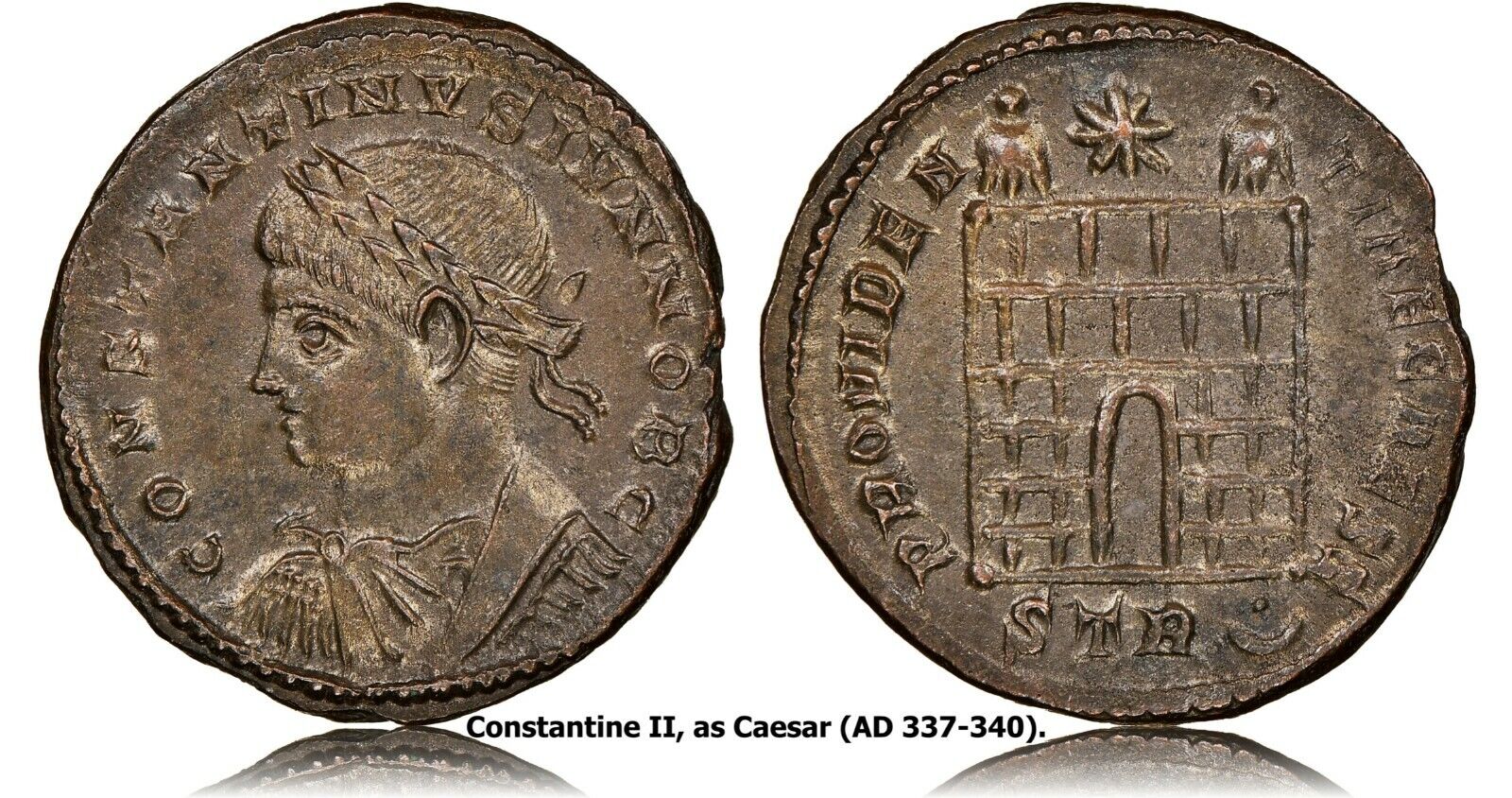-40%
CARACALLA Authentic Ancient 198AD ROME MINT Old Roman Coin VICTORY NGC i60237
$ 379.52
- Description
- Size Guide
Description
Item:i60237
Authentic Ancient Coin of:
Caracalla
-
Roman Emperor
: 198-217 A.D.
Bronze 26mm (12.85 grams) of Nicopolis ad Istrum in Moesia Inferior
under Magistrate Aurelius Gallus circa 198-209 A.D.
Certification:
NGC Ancients
XF 4375823-038
AV K. M AVP ANTΩNEINO, laureate head right.
VΠ AVP ΓAΛΛOV NIKOΠOLITΩN ΠPOC I, Victory on globe left, holding wreath and palm.
You are bidding on the exact item pictured, provided with a Certificate of Authenticity and Lifetime Guarantee of Authenticity.
Caracalla 198-217 A.D.
Caesar: 195-198 A.D. (under
Septimius Severus
)
Augustus: 198-217 A.D. (198-209 A.D. with
Septimius Severus
) (209-211 A.D. with
Septimius Severus
and
Geta
) (211 A.D. with
Geta
) (211-217 A.D. Sole Reign)
Son of
Septimius Severus
and
Julia Domna
| Brother of
Geta
| Husband of
Plautilla
| Nephew of
Julia Maesa
| Cousin of
Julia Soaemias
and
Julia Mamaea
|
Caracalla
(4 April 188 - 8 April 217), formally
Marcus Aurelius Severus Antoninus Augustus
, was Roman emperor from AD 198 to 217. A member of the Severan Dynasty, he was the eldest son of Septimius Severus and Julia Domna. Caracalla reigned jointly with his father from 198 until Severus' death in 211. Caracalla then ruled jointly with his younger brother Geta, with whom he had a fraught relationship, until he had Geta murdered later that year. Caracalla's reign was marked by domestic instability and external invasions from the Germanic people.
Caracalla's reign was notable for the Antonine Constitution (Latin:
Constitutio Antoniniana
), also known as the
Edict of Caracalla
, which granted Roman citizenship to nearly all freemen throughout the Roman Empire. The edict gave all the enfranchised men Caracalla's adopted praenomen and nomen: "Marcus Aurelius". Domestically, Caracalla was known for the construction of the Baths of Caracalla, which became the second-largest baths in Rome, for the introduction of a new Roman currency named the
antoninianus
, a sort of double
denarius
, and for the massacres he enacted against the people of Rome and elsewhere in the empire. Towards the end of his rule, Caracalla began a campaign against the Parthian Empire. He did not see this campaign through to completion due to his assassination by a disaffected soldier in 217. He was succeeded as emperor by Macrinus after three days.
Caracalla is presented in ancient sources as a tyrant and cruel leader, an image that has survived into modernity. Dio Cassius and Herodian present Caracalla as a soldier first and emperor second. In the 12th century, Geoffrey of Monmouth started the legend of Caracalla's role as the king of Britain. Later, in the 18th century, Caracalla's memory was revived in the works of French artists due to the parallels between Caracalla's apparent tyranny and that of King Louis XVI. Modern works continue to portray Caracalla as a psychopathic and evil ruler. His rule is remembered as being one of the most tyrannical of all Roman emperors.
Caracalla's father, Septimius Severus, died on 4 February 211 at Eboracum (now York) while on campaign in Caledonia, north of the Roman Britannia. Caracalla and his brother, Publius Septimius Antoninus Geta, jointly inherited the throne upon their father's death. Caracalla and Geta ended the campaign in Caledonia after concluding a peace with the Caledonians that returned the border of Roman Britain to the line demarcated by Hadrian's Wall. During the journey back to Rome with their father's ashes, Caracalla and his brother continuously argued with one another, making relations between them increasingly hostile. Caracalla and Geta considered dividing the empire in half along the Bosphorus to make their co-rule less hostile. Caracalla was to rule in the west and Geta was to rule in the east. They were persuaded not to do this by their mother.
On 26 December 211, at a reconciliation meeting arranged by their mother, Caracalla had Geta assassinated by members of the Praetorian Guard loyal to himself, Geta dying in his mother's arms. Caracalla then persecuted and executed most of Geta's supporters and ordered a
damnatio memoriae
pronounced by the Senate against his brother's memory. Geta's image was removed from all paintings, coins were melted down, statues were destroyed, his name was struck from papyrus records, and it became a capital offence to speak or write Geta's name. In the aftermath of the
damnatio memoriae
, an estimated 20,000 people were massacred. Those killed were Geta's inner circle of guards and advisers, friends, and other military staff under his employ.
Provincial tours
In 213, about a year after Geta's death, Caracalla left Rome never to return. He went north to the German frontier to deal with the Alamanni and Goths tribesmen, a confederation of migrating Germanic tribes who had broken through the
limes
in Raetia. During the campaign of 213-214, Caracalla successfully defeated some of the Germanic tribes while settling other difficulties through diplomacy, though precisely with whom these treaties were made remains unknown. While there, Caracalla strengthened the frontier fortifications of Raetia and Germania Superior, collectively known as the Agri Decumates, so that it was able to withstand any further barbarian invasions for another twenty years. Historian Edward Gibbon compares Caracalla to emperors such as Hadrian who spent their careers campaigning in the provinces and then to tyrants such as Nero and Domitian whose entire reigns were confined to Rome and whose actions only impacted upon the senatorial and equestrian classes residing there. Gibbon then concludes that Caracalla was "the common enemy of mankind", as both Romans and provincials alike were subject to "his rapine and cruelty".
After Caracalla concluded his campaign against the Alamanni, it became evident that he was inordinately preoccupied with the Greek-Macedonian general and conqueror Alexander the Great. He began openly mimicking Alexander in his personal style. In planning his invasion of the Parthian Empire, Caracalla decided to equip 16,000 of his men with Macedonian-style phalanxes, despite the Roman army having made the phalanx an obsolete tactical formation. The historian Christopher Matthew mentions that the term
Phalangarii
has two possible meanings, both with military connotations. The first refers merely to the Roman battle line and does not specifically mean that the men were armed with pikes, and the second bears similarity to the 'Marian Mules' of the late Roman Republic who carried their equipment suspended from a long pole, which were in use until at least the 2nd century AD. As a consequence, the
Phalangarii
of Legio II Parthica may not have been pikemen, but rather standard battle line troops or possibly
Triarii
. Caracalla's mania for Alexander went so far that Caracalla visited Alexandria while preparing for his Persian invasion and persecuted philosophers of the Aristotelian school based on a legend that Aristotle had poisoned Alexander. This was a sign of Caracalla's increasingly erratic behaviour. But this mania for Alexander, strange as it was, was overshadowed by subsequent events in Alexandria.
When the inhabitants of Alexandria heard of Caracalla's claims that he had killed his brother Geta in self-defence, they produced a satire mocking this as well as Caracalla's other pretensions. In 215 Caracalla travelled to Alexandria and responded to this insult by slaughtering the deputation of leading citizens who had unsuspectingly assembled before the city to greet his arrival, before setting his troops against Alexandria for several days of looting and plunder. Following the massacre at Alexandria, Caracalla moved east onto Armenia. By 216 he had pushed through Armenia and south into Parthia.
Julia Domna
During the reign of Septimius Severus, Julia Domna had played a prominent public role, receiving titles of honor such as "Mother of the camp", but she also played a role behind the scenes helping Septimius administer the empire. Described as ambitious, Julia Domna surrounded herself with thinkers and writers from all over the empire. While Caracalla was mustering and training troops for his planned Persian invasion, Julia remained in Rome, administering the empire. Julia's growing influence in state affairs was the beginning of a trend of emperors' mothers having influence, which continued throughout the Severan dynasty.
When Geta died in 211, her responsibilities increased because Caracalla found administrative tasks to be mundane. She may have taken upon one of the more important civil functions of the emperor; receiving petitions and answering correspondence. The extent of her role in this position, however, is probably overstated. She may have represented her son and played a role in meetings and answering queries; however, the final authority on legal matters was Caracalla. When Caracalla was murdered, Julia was in Antioch sorting out correspondence, removing unimportant messages from the bunch so that when Caracalla returned, he would not be overburdened with duties. The emperor filled all of the roles in the legal system as judge, legislator, and administrator.
Frequently Asked Questions
Mr. Ilya Zlobin
, world-renowned expert numismatist, enthusiast, author and dealer in authentic ancient Greek, ancient Roman, ancient Byzantine, world coins & more.
Who am I dealing with?
You are dealing with Ilya Zlobin, ancient coin expert, enthusiast, author and dealer with an online store having a selection of over 15,000 items with great positive feedback from verified buyers and over 10 years experience dealing with over 57,000 ancient and world coins and artifacts. Ilya Zlobin is an independent individual who has a passion for coin collecting, research and understanding the importance of the historical context and significance all coins and objects represent. Most others are only concerned with selling you, Ilya Zlobin is most interested in educating you on the subject, and providing the largest selection, most professional presentation and service for the best long-term value for collectors worldwide creating returning patrons sharing in the passion of ancient and world coin collecting for a lifetime.
How long until my order is shipped?
Orders are shipped by the next business day (after receipt of payment) most of the time.
How will I know when the order was shipped?
After your order has shipped, you will be left positive feedback, and that date could be used as a basis of estimating an arrival date. Any tracking number would be found under your 'Purchase history' tab.
USPS First Class mail takes about 3-5 business days to arrive in the U.S. International shipping times cannot be estimated as they vary from country to country.
Standard international mail to many countries
does not
include a tracking number, and can also be slow sometimes.
For a tracking number and signature confirmation, you may want to do Express Mail International Shipping, which costs more, however, is the fastest and most secure. Additionally you may be able to receive your order in as little as 3-5 business days using this method. For Express Mail International, it may be possible to place up to 10-15 items in one package (for the one shipping cost) as it is flat rate envelope, which may be the most cost-effective, secure and fastest way to receive items internationally. Send me a message about this and I can update your invoice should you want this method.
Getting your order to you, quickly and securely is a top priority and is taken seriously here.
Great care is taken in packaging and mailing every item securely and quickly.
Please be aware, I cannot take responsibility for any postal service delivery delays, especially for international packages as it may happen in rare instances.
What is a certificate of authenticity and what guarantees do you give that the item is authentic?
Each of the items sold here, is provided with a Certificate of Authenticity, and a Lifetime Guarantee of Authenticity, issued by a world-renowned numismatic and antique expert that has identified over 57,000 ancient coins and has provided them with the same guarantee. You will be very happy with what you get with the COA; a professional presentation of the coin, with all of the relevant information and a picture of the coin you saw in the listing. Additionally, the coin is inside it's own protective coin flip (holder), with a 2x2 inch description of the coin matching the individual number on the COA.
On the free-market such a presentation alone, can be considered a - value all in itself, and it comes standard with your purchases from me,
FREE.
With every purchase, you are leveraging my many years of experience to get a more complete context and understanding of the piece of history you are getting. Whether your goal is to collect or give the item as a gift, coins presented like this could be more prized and valued higher than items that were not given such care and attention to.
Buy a coin today and own a piece of history, guaranteed.
Is there a money back guarantee?
I offer a 30 day unconditional money back guarantee. I stand behind my coins and would be willing to exchange your order for either store credit towards other coins, or refund, minus shipping expenses, within 30 days from the receipt of your order. My goal is to have the returning customers for a lifetime, and I am so sure in my coins, their authenticity, numismatic value and beauty, I can offer such a guarantee.
When should I leave feedback?
Once you receive your order, please leave a positive feedback. Please don't leave any negative feedbacks, as it happens sometimes that people rush to leave feedback before letting sufficient time for their order to arrive. Also, if you sent an email, make sure to check for my reply in your messages before claiming that you didn't receive a response. The matter of fact is that any issues can be resolved, as reputation is most important to me. My goal is to provide superior products and quality of service.
How and where do I learn more about collecting ancient coins?
Visit the
"Guide on How to Use My Store"
for on an overview about using my store, with additional information and links to all other parts of my store which may include educational information on topics you are looking for.













